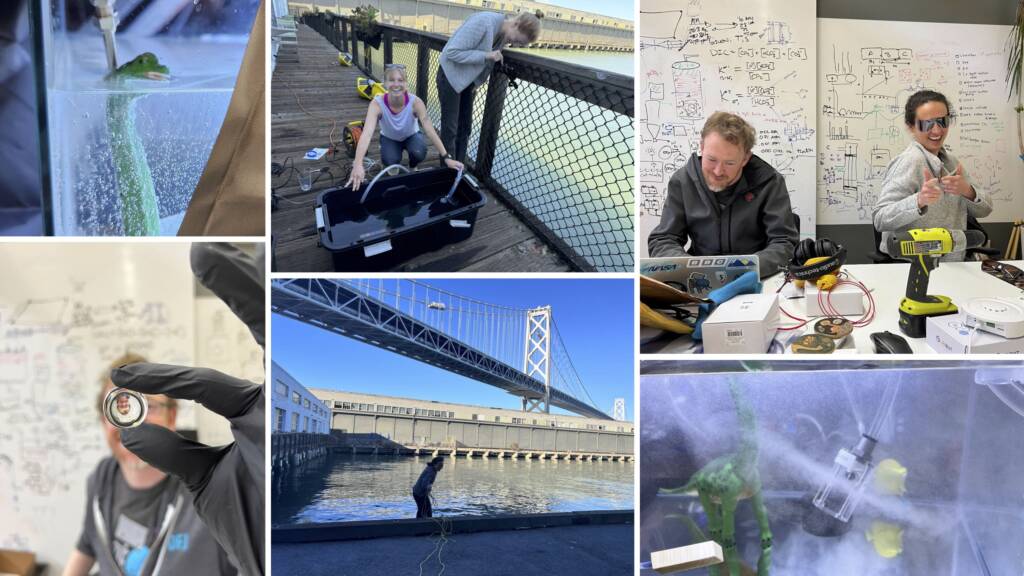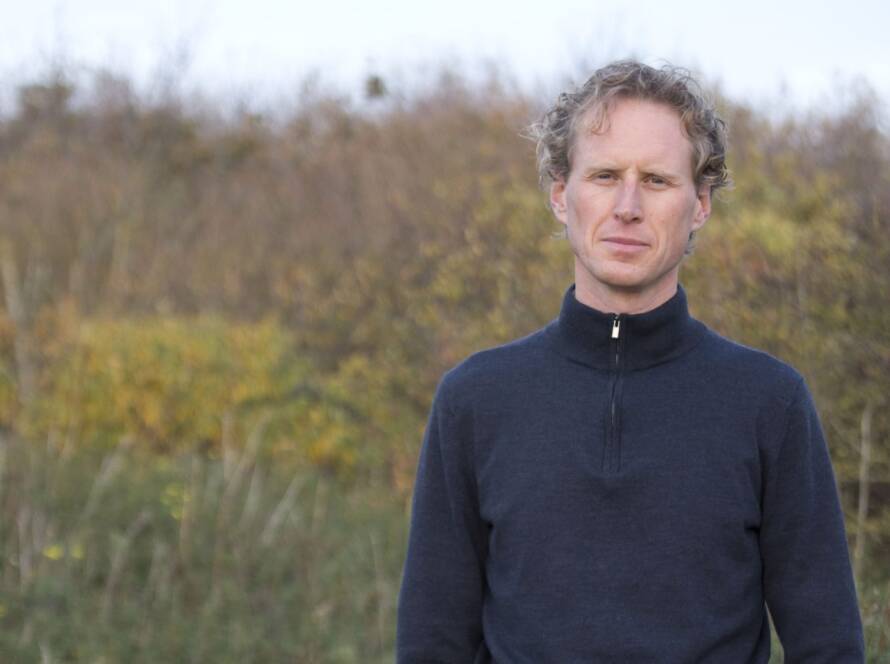Kelly and Shaun Kinetic were co-founders of Charm Industrial, a successful carbon removal company that converts agricultural waste into bio-oil to trap carbon in the ground. Even with the success of the company, the Kinetics, together with Lea Eaton and Lauren Murray, their R&D leaders, realized that carbon dioxide removal (CDR) is not scaling quickly enough to combat the magnitude of climate change, and decided to move to mitigation pathways that are theoretically explored but not yet scientifically proven.
After digging around for a promising but under-researched idea, the four of them settled on the concept of generating ultrafine bubbles near the surface of the ocean to reflect back solar radiation, just as clouds do in the air. They set up a new research organization, Undercurrent, to investigate its feasibility.
Why focus on cooling the seas? Well, the ocean absorbs 90% of excess heat from greenhouse gases. Due to humanity’s ever-rising emissions, it’s heating at a precipitous rate, with average temperatures breaking records every single day since May 2023 (let that sink in!). Cooling the oceans, then, is crucial for stabilising global temperatures.
What’s more, the jump in ocean temperatures is devastating critical ecosystems, with over half of the ocean’s corals already killed off. Cooling the oceans would not only save marine life, but also improve coastal protection against storm damage.
Undercurrent’s approach would, ideally, use no chemicals, no soap, no external power source — just air bubbles powered by waves, acting like mini mirrors in the ocean to reflect solar heat back to the atmosphere. It would be reversible, cost-effective, and if it works, even on a small scale, could lead to significant ocean cooling, saving corals and marine life. On a much larger scale, it could cause a meaningful dent in global warming.
At the moment, it’s merely a research concept. We’re giving Undercurrent a grant, joining the Navigation Fund and the Kissick Family Foundation, to study the cooling potential of such a model, and to develop the technology.
The idea of using microbubbles to shade the ocean isn’t new — the idea was first floated by Russell Seitz, a Harvard professor, in a 2010 paper. “Since water covers most of the earth, don’t dim the sun,” he told a conference. “Brighten the water.” Seitz pointed out that natural bubbles already brighten rough seas and create a luster known as “undershine”. Generating bubbles would simply be amplifying this natural phenomenon. Since Seitz’ work was published, the Reef Restoration and Adaptation Program (RRAP) has considered it, but didn’t have the bandwidth or budget to explore further.
“We were excited about using our skills to accelerate different climate interventions,” says Kelly. “It was one of those projects where we felt like we were very well-poised to do it. We were excited about the idea that as four people we could either contribute a small piece to the larger effort of stratospheric aerosol injection or marine cloud brightening, or we could find out whether bubbles are a possibility, and get the concept much further in just a year’s time.”
Another reason the team found the concept of ultrafine bubbles exciting was that they could start on a small scale at first and their efforts and results could still be meaningful.
“Most climate interventions require you to start with impact on a global scale. And this one could start on a really local scale for corals or specific areas of the ocean, and we were curious about whether we could take that to a global scale afterwards,” says Kelly.
To get an idea of the potential impact of the concept if it works, the team calculated that ultrafine bubbles could cool the ocean by -2.5 watts per square meter. And if that says nothing to you: if the bubbles were deployed across five percent of the ocean (the equivalent of Russia’s landmass), that would, in theory, reflect 45 terawatts of energy (the energy emitted by a small hurricane) back to space instead of allowing it to heat the Earth, which represents enough cooling to reach one of the IPCC’s intermediate pathways.
Of course, this assessment is based on a large set of assumptions, and covering five percent of the ocean would not only require a fantastic amount of effort, resources, and research, it’s also not desirable. At that scale, there would almost definitely be problematic secondary consequences. Like CarbonFix, rather than thinking in terms of “silver bullet” innovations — one grand idea that will solve the the climate crisis in one fell swoop — Undercurrent prefer to think in terms of “silver buckshot”, or a multitude of diverse smaller solutions, each appropriate for the local context and needs. Bubbles can’t be the only thing we rely on — but they can be part of the multitude.
First steps
Microbubbles, which range from thinner than a human hair to a grain of table salt, only last minutes to hours in the ocean. But nanobubbles, which are up to 200 times smaller, can actually survive hours, days, or even months. However, in the complex environment of the ocean — where currents, weather conditions, the chemical make-up of the water and local wildlife will all impact bubble lifespan — a lot still needs to be tested.
Undercurrent’s first step is to investigate the specific longevity of nanobubbles in saltwater, whether they adequately reflect light back into the atmosphere, and to what extent that cools the water below. Even though nanobubbles are used in agriculture, bio-tech, and wastewater treatment, there has never been a market need for the very particular range of bubble sizes that Undercurrent believe would be effective in the ocean, which have a diameter roughly 250 times thinner than a human hair.
They also want to investigate why bubbles of this size might shrink, merge, or disappear in saltwater — and whether adding a gas or surfactant might help them survive longer. While it’s not desirable to add anything into the ocean, it would be good to understand the limitations from a research perspective.
“I’m excited about the side benefits of some of this testing. With any of these problems, you learn about the constraints — which then gives you opportunity for more innovation,” says Kelly. “Once you identify: ‘This could work, but we’re limited by X’, then you uncover some interesting engineering problems.”

In a few months’ time, they want to go to Scripps’ Ocean-Atmosphere Research Simulator in San Diego, to test how long the bubble might last in dynamic saltwater with wind currents.
The team want to make their findings widely available, with the aim of building a foundation for future research and innovation in this space. Although ultimately they would want to test it in-situ, they want to first engage with experts to better understand the potential impacts of their findings before taking it to a local ecosystem.
Mitigation is riskier — but we have to do it
Climate interventions, also known as climate mitigation, are seen as far riskier and more controversial than carbon dioxide removal. Many people are wary of interfering in weather systems and the undesirable consequences that could result.
Yet many of those familiar with the science accept that we will simply not be able to meet our climate goals with carbon avoidance and reduction.
“We saw how difficult it would be to have impact on a massive scale with carbon dioxide removal and how it was going to take a war-like effort — in terms of money, people, and work — for it to be the only thing we do to combat climate change,” says Kelly.
Mitigation can also be pricier, not to mention politically complex. Just imagine trying to install infrastructure across even one percent of the oceans — it would require cooperation and treaties across many nations.
That risk and complexity is why most investors shy away from oceanic mitigation projects. And it’s also precisely why CarbonFix chose to work with Undercurrent.
We don’t have certainty that it will work, and Undercurrent as yet have no idea about what consequences their intervention could have. Could bubble shading affect weather patterns, or ocean circulation, in unintended ways? Could it interfere with ecosystems in ways we do not yet understand? These uncertainties are precisely why climate interventions require rigorous, transparent, and independent research — and why other investors have shied away from the idea. But at CarbonFix, we believe that when we have doubts, it’s actually a sign we should say Yes. To go where others fear to tread.
To conduct that rigorous, independent research, Undercurrent currently have their “researcher” hat on, says Kelly. If the concept is promising, they would like to take it as far as they can, but hope that others would take note of their data and build their own systems.
“With all climate intervention concepts, there are very specific ethical lines and sensitivities we want to be cognizant of. We believe that interventions might need to be in the hands of a government, or a local community that is stewarding the landscape. We don’t need a horse in the race to be the ones to scale it, but rather we want to further the research, see what’s possible, and provide information,” says Kelly.
We’re incredibly excited to see what emerges from Undercurrent’s research. While the concept may seem audacious today, the most transformative climate solutions often begin as seemingly impossible ideas. If their work proves successful, we could be witnessing the early stages of an extraordinarily promising pathway to ocean cooling—one that could help preserve marine ecosystems and contribute meaningfully to our climate response.




